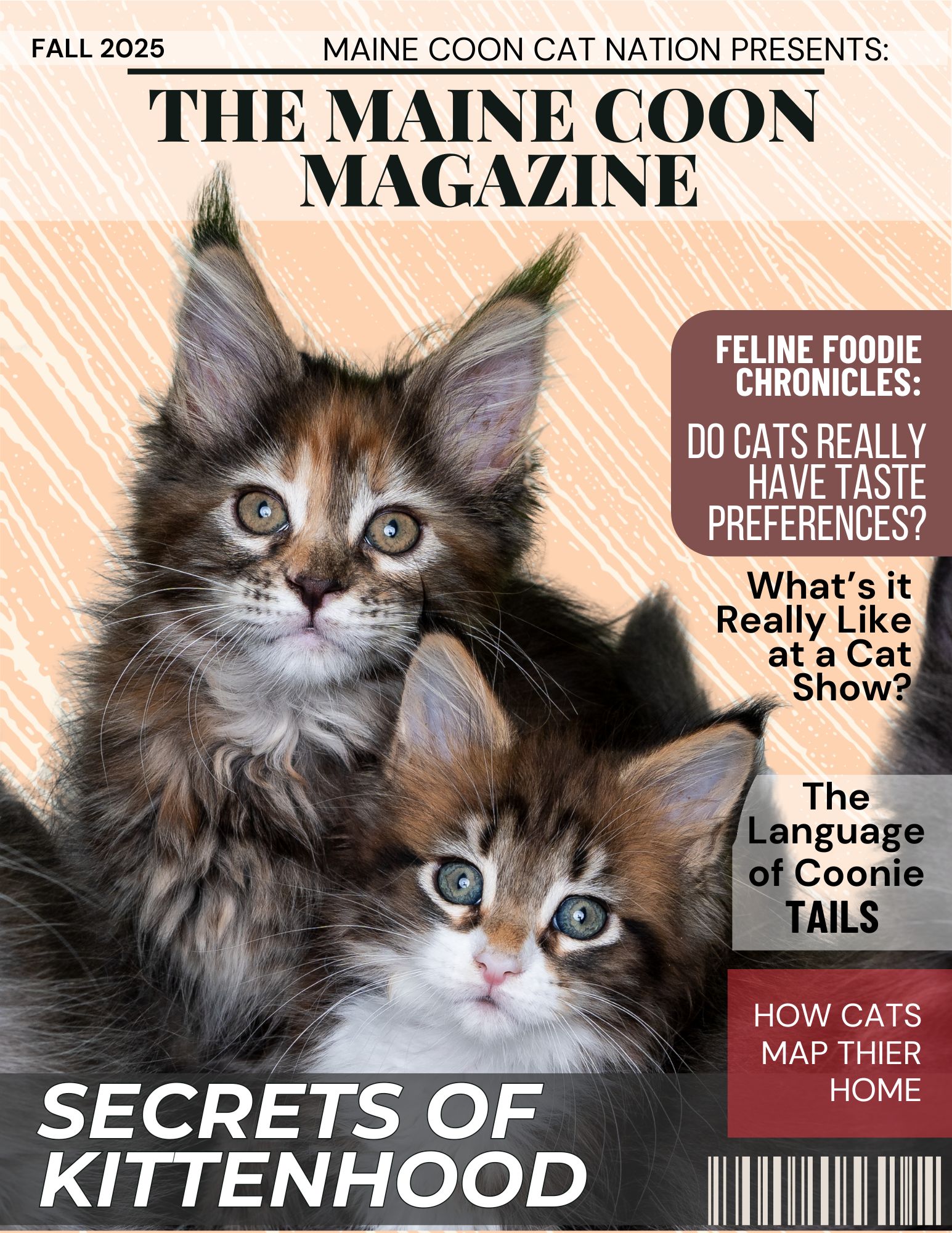- Home
- Maine Coon Care
- Walking Cats On Leash
Disclosure: this site is reader-supported. When you buy through links on our site, we may earn a small commission, at no extra cost to you.
Walking Cats On Leash
Leashes, Harnesses, Locators & Safety Q & A's
What do you think about walking cats on leash? I think most of us have tried it, or at least considered it.
It sounds like fun to walk a cat! Many actually really like it, so let's talk about how to walk a cat!
If you like this, you'll love our fun, free Daily Digest!

If you like this, you'll love our fun, free Daily Digest!

Walking your cat on a leash can be a fun and enriching experience for both of you!
It's a great way to give your Coonie some fresh air and mental stimulation while exploring the great outdoors together.
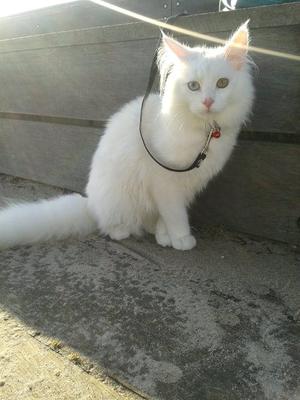 Missy
MissyNot only does it help keep your kitty active and healthy, but it also strengthens the bond between you.
Just take a look at adorable 9 month old Missy sporting a leash and getting used to it!
Plus, it's a fantastic way for your cat to safely satisfy their natural curiosity. Why should dogs have all the fun?
FAQ's About Walking Cats on Leash and Harness
Is it safe to walk a cat on a leash?
Is it safe to walk a cat on a leash?
Walking a cat on a leash can be safe if done correctly. The key is to ensure they comfortable with the harness and leash, and that you're in a safe, controlled environment.
Start by introducing the harness indoors, letting your cat get used to it gradually. Avoid busy streets or areas with loud noises that might frighten your cat.
Always keep an eye on your cat's behavior, and never force them to walk if they seem stressed or uncomfortable.
How do I train my cat to walk on a leash?
How do I train my cat to walk on a leash?
Start by choosing a well-fitted harness designed for cats, as collars can be unsafe. Let your cat get used to the harness indoors before attaching the leash.
Once they're comfortable, begin with short walks around the house, rewarding them with treats for staying calm. Gradually increase the time and introduce the leash.
When your Coonie is ready, try short, calm outdoor sessions in a secure area. Patience is key - some kitties may take weeks to adjust.
What kind of harness is best for walking a cat?
What kind of harness is best for walking a cat?
A well-fitted, adjustable harness that secures around their chest and neck is ideal. Look for harnesses specifically designed for cats, as they are less likely to slip out of them.
The harness should be snug but not tight, allowing room for two fingers between the harness and your cat's body. Avoid harnesses that restrict movement or press too hard on the neck.
Popular types include vest-style harnesses and H-style harnesses, both offering comfort and security.
Can all cats be trained to walk on a leash, or are some better suited than others?
Can all cats be trained to walk on a leash, or are some better suited than others?
Not all kitties will enjoy or adapt to leash walking, but many can be trained with patience. Kittens and young cats are generally more adaptable and curious, making them easier to train.
Older cats can also learn if they are willing and interested. Cats with a more laid-back, adventurous, or curious personality are often better suited for leash walking.
Felines that are highly anxious or fearful might not enjoy the experience, so it's important to assess your cat's temperament.
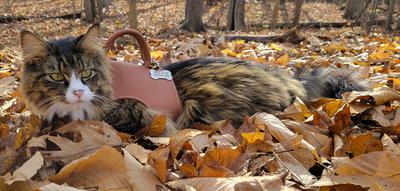 Jack in his harness
Jack in his harnessHow long does it take for a cat to get used to wearing a harness?
The time it takes to get used to a harness can vary widely depending on the individual cat. Some may adapt within a few days, while others might take weeks or even months.
Start by letting your Maine Coon wear the harness for short periods indoors, gradually increasing the time as they become more comfortable.
Use positive reinforcement, like treats and praise, to create a positive association with the harness. Be patient and let your fur-kid adjust at their own pace.
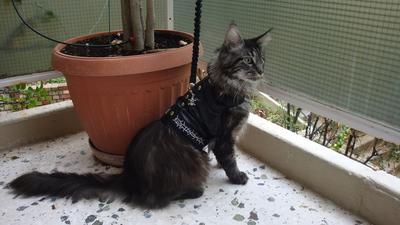 Jeronimo
JeronimoFor example, Jeronimo, one of our community's stars, knows that to go out on their front balcony, he must be harnessed or taken out in their arms.
Over time, some cats will naturally associate the harness with outdoor adventures, making it a routine they come to expect.
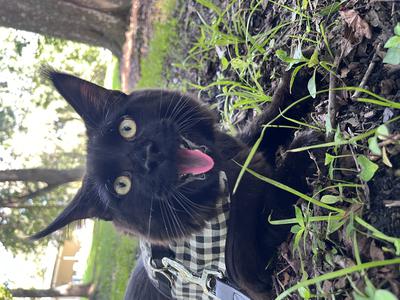
Amy in FL shares that her boy Apollo "loves to go walking outside on a leash and climbs to the top of trees as far as his leash will allow him which is 26 feet!"
What are the benefits of walking a cat on a leash?
Walking a cat on a leash offers mental and physical stimulation, helping to satisfy their natural curiosity and hunting instincts.
It can reduce boredom and associated behavioral issues, like scratching furniture or over-grooming.
Leash walking also provides exercise, helping to maintain a healthy weight. Additionally, it strengthens the bond between you and your feline friend, as you share new experiences together.
For indoor cats, leash walking is a safe way to explore the outdoors without the risks of free-roaming.
Are there any risks associated with walking a cat outdoors?
While leash walking can be enriching, there are risks to be mindful of.
They can become frightened by loud noises, unfamiliar animals, or sudden movements, leading to panic or attempts to escape. Ensure the harness is secure to prevent them from slipping out.
Also, be cautious of environmental hazards like traffic, toxic plants, or pesticides.
Keep your kitty away from stray animals to reduce the risk of disease transmission or injury. Always supervise closely during outdoor walks.
How can I keep my cat calm and comfortable while walking outside?
Start in a quiet, familiar area with minimal distractions.
Gradually introduce new environments as they gain confidence. Keep the first few outdoor sessions short and positive, using treats and praise to reward calm behavior.
Allow your Maine Coon to explore at their own pace without pulling on the leash.
If your Coonie shows signs of stress, such as crouching, tail flicking, or trying to hide, it’s best to return indoors and try again another time.
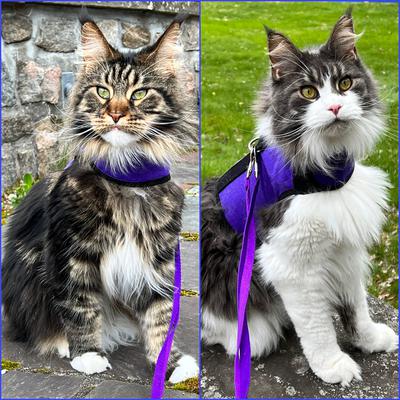 Violet and Kahleesi like to go for walks harness and leash
Violet and Kahleesi like to go for walks harness and leashWhat should I do if my cat gets scared or tries to run away during a walk?
If she becomes scared or attempts to flee, stay calm and avoid pulling on the leash, which could increase their fear.
Instead, pick them up or gently guide them to a safe, quiet spot where they can regain composure.
Speak in a soothing tone and offer treats to create a positive distraction. If she remains fearful, it's best to end the walk and return indoors.
Over time, gradually reintroduce the outdoor experience, allowing your Coonie to build confidence at their own pace.
Is it okay to walk a cat in any type of weather?
This depends on your kitty's temperament - is their desire for fresh air stronger than their aversion to a hot day, rainy day or snowy one? If not, they would probably prefer the comfort of home.
Avoid extreme temperatures - too hot can lead to overheating, while too cold can cause discomfort.
Rain, snow, or high winds may also distress your cat. Always check the ground temperature with your hand; if it's too hot for you, it's too hot for a cat's paws.
In warm weather, walk during cooler parts of the day, like early morning or evening. Always prioritize safety and comfort.
How far or how long should I walk my cat?
The duration and distance of your walk should be based on your cat's comfort level and interest.
Start with short sessions, about 5 to 10 minutes, and gradually increase the time as your kitty becomes more accustomed to walking.
Some felines may enjoy longer walks of 20 to 30 minutes, while others might prefer shorter, exploratory sessions.
Pay attention to your Coonie's behavior - if they seem tired, stressed, or disinterested, it's time to head home. The goal is to make the experience enjoyable, not exhausting.
Can I walk my cat in public places like parks?
Walking your cat in public places like parks can be enjoyable, but it requires careful planning and depends on your Coonie's temperament.
Choose quieter times when there are fewer dogs and people around.
Always keep your cat on a leash and harness, and stay vigilant for potential dangers, such as off-leash dogs, noisy children, or wildlife.
Some parks may have specific rules about pets, so check regulations before your visit.
Be prepared to leave if your cat becomes overwhelmed.
What should I bring with me when walking my cat?
Bring essential items to ensure their safety and comfort. A sturdy leash and well-fitted harness are crucial.
Carry treats to reward good behavior and encourage exploration. Water is important, especially on warmer days, so bring a portable water dish if you are away from home - for example, on a camping trip.
It's also helpful to have a small towel for unexpected messes. If your cat is new to walking outdoors, a carrier or backpack can provide a safe space if they become frightened.
How can I ensure my cat doesn't escape from the harness?
To prevent escaping, choose a harness that fits snugly but comfortably. For large Maine Coons, that may mean choosing a harness for small dogs.
It should be tight enough that they can't wriggle out, but loose enough to allow two fingers to fit between the harness and body.
Before heading outside, check all buckles and straps to ensure they're secure. Practice indoors first to make sure your cat is unable to slip out.
Some felines are more adept at escaping than others, so always keep a close eye on them during walks.
What should I do if my cat encounters other animals while on a walk?
Remain calm and observe their reactions closely. If the other animal is friendly and your Maine Coon seems curious, allow them to approach slowly while keeping a firm hold on the leash.
However, if either animal shows signs of aggression, fear, or stress, calmly but quickly guide your cat away, or even swiftly scoop him or her up, to avoid confrontation.
It's important to be aware of potential threats, such as off-leash dogs, and always be ready to pick up your cat if needed for safety.
Community Discussions About Walking Cats on Leash and Harness:
Here are our community questions and answers related to cat harnesses, leashes, locators, and cats outside. Just scroll down to read more about walking cats on leash:
- "Pet Loc8tor - Do You Use It?"
- "Can I walk my Maine Coon kitten?"
- "Indoor Kitten Outside - Briefly ???"
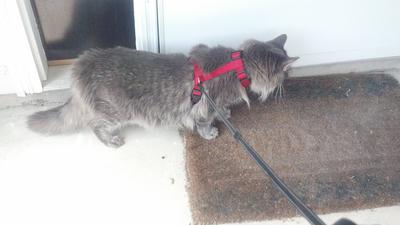 Pepper going for a walk
Pepper going for a walkCan I walk my Maine Coon Kitten? - Walking Cats on Leash
by: Allison in California
I have a male rescue kitten of 10 months old, and he's getting huge! Because he's a rescue and was from an abandoned litter, they didn't know what breed he was.
He has all the traits of a Maine Coon and physical characteristics, so we're pretty sure he is one.
He's about 3 1/2 feet long when fully stretched out, and he's already bigger than all of the full grown male cats on our street!
I wanted to know if I could walk him on a leash around the neighborhood.
I've never seen any loose animals besides a cat hiding in the bushes from time to time, and there are usually a couple other people walking their dogs, but it's easy to avoid a run in with another animal.
He's getting too big to spend all his time indoors, and I don't want to put him in the backyard because a mommy cat and her 3 kittens are living back there until we can get them to a rescue center.
My kitten plays too rough with them because he doesn't realize how huge he is.
If I can walk him on leash, also, what kind of leash should I use? And for how long and how frequently?
He really wants to get outside, but I can't just let him roam free. I don't want him to get hit by a car or get lost.
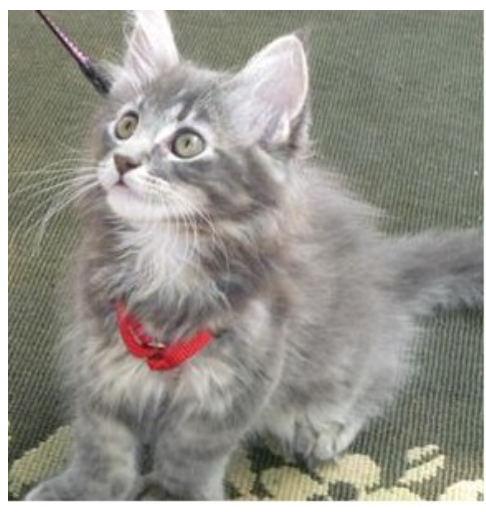 Buster on Leash
Buster on LeashReply:
Hi Allison,
You've made a good, responsible decision to keep your boy indoors! I'm sure he wants to go outside.
Our cats still try to make a break for it from time to time, but nothing like when they were younger.
A few of our Maine Coon Cat Nation friends have posted about enjoying walking their cat on leash - like Mr. Buster here in the accompanying photo!
I walked Alice and Leo when they were young, just in the yard, though I didn't take pictures at the time.
They style I used was actually made for rabbits. It was flexible and designed so they couldn't wriggle their front legs out.
I think an adult Maine Coon would be too large for this, though.
There are a couple of nice kitty harnesses made just for cats available through Amazon for walking cats on leash.
I've had success ordering pet supplies through them. Here is one you might like to check out:
Come With Me Kitty Harness. It has well over 7 thousand reviews in the large size ;)
As for his needing to go out because of his size and the fact that he's begging, you certainly can, and he'll love it, but it's not essential.
There are huge Maine Coon cats stay indoors all the time and live full happy lives, too.
Hope this helps! Maybe some others will chime in with their walking cats on leash experiences, too!
All The Best,
Carrie
Comments:
Leash training
by: Sharon
Hi Alison,
We started leash training all three of our boys shortly after they came home from the breeder and the process was seamless, they all took to it right away.
 Mulder on his harness
Mulder on his harnessWe simply started by putting the harness on for a few minutes each day so they could get used to it.
Once they were used to it then we tried the leash. It might take a little longer for your 10 month old, but be patient.
We walk our boys around the yard and have taught them their boundaries beyond which thy are not allowed to go.
This has helped when they occasionally bolt out the door. They run to the boundary and stop. We travel with them on vacation sometimes and being leash trained helps a lot.
This way they can get outside when there is a safe place to do so.
We use Lupine brand harnesses with great success.
Good luck, and post a picture when you get the chance!
Addendum
by: Sharon
The cat Lupine Harnesses are too small for most coons. We use the one for small dogs.
Can I walk my Maine Coon kitten?
by: Kim
I would never walk a cat on a leash. First off, what seems a short distance to you, due to your long legs and metabolism, is an extremely long and enduring walk to a cat.
Also, cats probably do not enjoy being forced to walk long distances. Lastly, if your he is sick, even if it doesn't show it, this can be an agonizing stress on your cat.
Thanks!
by: Allison
Yes, this all really has helped a lot! And I would never take my kitten for a walk if he didn't want to go!
He just really wants to be outside, but it can be dangerous. He runs so much faster than me, so I don't want to have to be chasing him around the block.
But, thank you all, very much, for this great information!
Pet Loc8tor - Do You Use It?
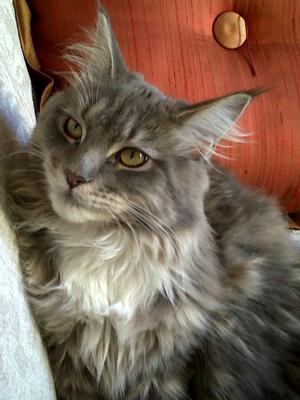 Diva Molly
Diva MollyHi Carrie and MC devoted slaves,
Having read about Molly from S.Africa's Pet Loc8tor,
I'm curious if anyone in England/UK allows their MC (with loc8tor) freedom? And, how it worked, if it had to?
Glad to hear the gadget has been updated. Has anyone in my area bought one recently?
JUDY, South England
Indoor Kitten Outside - Briefly ???
We have a 18 week old silver tabby male Maine Coon called Buddy and wonder if letting him outside briefly - on a harness and lead would be a good thing?
We want to enrich his life, not put his health in danger. We will remain in our house most of the time.
In the summer we want to design and build an enclosure, sooooooooo until then ????
Has anyone designed and built their own? What are the pitfalls? I wish ANY one of the cat mags would feature them.
We have a bird feeders in the front & back garden about 35 feet from our windows. A fox used to wander in but haven't seen much evidence lately.
A semi feral cat wanders through, plus a young deer sometimes(the type with white spots). Incidentally, Buddy has had his vaccinations etc.
He's rambunctious, very bold, greedy and persistent. While waiting at the vets - for his 2nd vaccination, a pitbull was sniffed in his direction. What did Buddy do?
He stood up and pawed the grill and sniff in the dog's direction :) lol.
Has anyone tips on persuading him from scratching the doors? New paintwork has gone for a burton :(
It is wonderful to be able to contact like minded m.c. people.
Best wishes
Judy
Reply:
Hi Judy,
I think it is fine to try Buddy on a leash! Many Maine Coon owners enjoy walking their cat on leash, and the best time to start is when they are young.
 Parker enjoying his yard
Parker enjoying his yardJust be prepared for him to love it so much he makes a break for it every time you open the back door!
Our cats have all but forgotten about going out. Alice sometimes tries to sneak over if it's left open, but that's it.
In the dead of winter, we let them on the back deck in the snow (it's covered)!
They sniff around, don't like to get their paws wet, and come back to the warmth of the hearth pretty soon! I think it's good for them, though!
As for the enclosures, there are a couple of companies out there. They can be expensive. Making your own is a great idea!
By the way, you also have a few comments about walking cats on leash over on our Facebook page.
Best Wishes,
~Carrie
Do You Have a Related Cat Question? Ask Us Here!
Do you have a question? Fill out the form below to get an answer! Give us as much information as you can, so we can best understand your unique cat questions!
« Back to Maine Coon Cat Care
